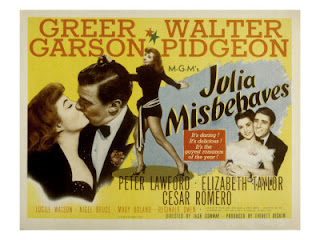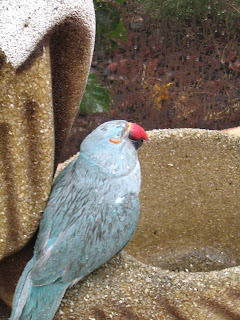I recently saw a wonderful film called
Portrait of Jennie (1948), starring Jennifer Jones and Joseph Cotten and produced by David O. Selznick, and I noticed in the credits that it was based on a book by the same title written by Robert Nathan. I was not previously familiar with the works of Robert Nathan, but I loved the movie so much that I was intrigued.
Fortunately,
Portrait of Jennie (the novel) is still in print, and a new copy can be purchased on Amazon at a reasonable price. After obtaining my copy, I began to read it. It's a short novella and can be read in one or two sittings. The story is of a struggling painter in New York City, Eben Adams, who meets a young girl in the park on a cold winter day. He finds her fascinating and mysterious (she talks about the past, present, and future in a rather ethereal way and seems to belong to the past) and hopes to meet her again to paint her. The continue to meet over the course of a year, but each time Jennie is significantly more grown up and they eventually fall in love. Eben finally finishes his portrait of Jennie, and it is the best work he has ever done, but Jennie continues to experience things that could have only happened in the past. There is much left unexplained in the story, and the ending in the movie is different from the book, though both are tragic. On the whole, it is a beautifully written and haunting love story, and it made me want to seek out more books by Robert Nathan.
Unfortunately, I realized that most of his books are out of print. My search led me to Alibris.com, an online bookseller that seems to specialize in rare and out of print books. I was very pleased to discover that they had several Robert Nathan books in stock!!
The next book I read was called
The Enchanted Voyage. It tells the story of Mr. Pecket, a lonely and unhappily married man who lives in the Bronx. He isn't very successful in his business, so much that he is losing money, and his wife is constantly disappointed in him. Mr. Pecket escapes reality by sitting in an old boat that he owns that supposedly would sink if it were put in water and daydreams about being a sailor. In an attempt to make money, Mrs. Pecket sells the boat to a neighbor who plans to make a lunch counter out of it, and then she puts wheels on it so it can be transported. While sitting in his boat with wheels on a stormy night and brooding about how his wife could do such a thing to him, the boat accidentally begins to sail away down the street, and Mr. Pecket's imagination runs away with it. He picks up a lonely waitress who is also trying to escape her own reality, and eventually a young, struggling and traveling dentist joins them too. The dentist and the waitress of course fall in love, but the three of them embark on a journey south, never leaving dry land but pretending to be sailing on the sea. The themes of the book are clearly escaping reality, and doing rather than just dreaming. The style and prose are lovely, but the story is a little too drawn out to be entertaining the entire time.
I was also able to get a collection of five Robert Nathan novels entitled
The Barly Fields. Contained in the book are
The Fiddler in the Barly, The Woodcutter's House, The Bishop's Wife, The Orchid, and There is Another Heaven. The only one I have read so far is
The Bishop's Wife. This was of course made into a movie in 1947 starring Cary Grant, Loretta Young, David Niven, Monty Woolley, and Gladys Cooper and since it is one of my all time favorite movies, I was excited to discover that Robert Nathan wrote the book!
Because I know the film so well, I am more inclined to make comparisons here than with
Portrait of Jennie, which I have only seen once. The book and movie were also quite similar in that case. Here,
The Bishop's Wife novel was fairly similar to the movie, but the names were changed a bit. The angel is called Michael in the book and Dudley in the movie, and Loretta Young's character is Juliet in the book and Julia in the movie. In general, the book has less comedy than the movie and is more religious in nature. The movie perhaps shows more weakness in the angel in his love for Julia, while the movie emphasizes the difference between a holy love and an earthly love between humans. Juliet is also more conflicted in her feelings for the angel in the book than Julia is in the movie.
Given the time period in which the book was written, I was surprised at the admission of Juliet's husband's shortcomings in their marriage. Juliet is the somewhat neglected wife of a bishop plagued by financial troubles. In answer to a prayer, an angel is sent to remedy the situation but in the meantime falls in love with Juliet. The movie provides more resolution at the end of the story between Juliet and her husband than the book, but the book contains very beautiful spiritual passages that the movie lacks. All in all, both the book and the movie are very entertaining, enlightening, lovely, and worth reading and watching, especially at Christmas time.
Also, a more recent movie was made based on the same story entitled
The Preacher's Wife (1996)
, starring Whitney Houston and Denzel Washington. I'm sure it is probably the most well known of the two films and book, and though many changes were made to the story and setting, it is a lovely film in many ways on its own.
I'd like to close with a selection from a passage written by Robert Nathan entitled
A Note to the Younger Generation.
"The truth is that what we call real changes every time the world breathes. My critics complain that I do not write about the real world. To discuss the loves and disappointments of little girls and old men, of mice and roosters, seems preposterous to the young realists of today. Yet what is more real than the hopes and griefs of children? Is a labor union more actual than a doll? Each signifies something in the human heart; neither one seems any more, or any less, significant.
That is not as absurd as it sounds. If little girls did not care to play with dolls any more, the world would be very different. It does not take genius to make such a remark, there is nothing new about it, but it is comforing, because it is true.
One of the most agreeable discussions of realism occurred recently, at luncheon. My step-daughter, aged four, who was eating her spinach, looked up suddenly, and remarked in a dreamy voice, 'I know a little boy who turned into a flower.' That, of course, was fantasy. Her brother, aged six, is the realist of the family. He exclaimed with energy, 'That's silly. You have to say what he ate that made him turn into a flower.'
I like the young writers of today. I like the hard, clear quality of their prose. But I do not believe that what they talk about is any more real than Little Red Riding Hood. It is good and pleasant to be manly and strong, to have broad shoulders and a shaggy chest; but it is inside the chest that the heart beats and the blood moves.
I know that falsehood and meanness, brutality and arrogance have increased in the world during these last ten years. Still, there is no reason to make a cult of them. They cannot continue to increase forever, since long before that they will have had to swallow one another like the snakes in the fable. Merely to be muscular and violent proves nothing; unless the bones of the dinosaur can be said to prove anything.
Perhaps it is not necessary to prove anything. Perhaps it is enough to say: We lived; and these were our hopes and our worries, our joys and our fears. This is the way we spoke, if not altogether with our tongues, at least with our hearts."
Robert Nathan
New York, December, 1937






















